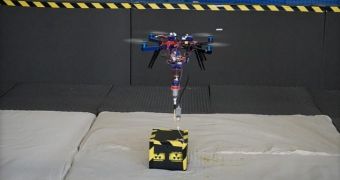It's one thing to have 3D printing pens and another to install things along similar lines on flying objects. Nevertheless, a team of inventors led by Dr. Mirko Kovac of the Imperial College of London's Department of Aeronautics has done just that.
By now, the world is well acquainted with flying drones, those small robots or machines that can fly, both independently and remote controlled.
It is drones of that sort that were outfitted with 3D printing guns. Well, technically, they're more like glue guns, but the technology does cross over, if only a little bit.
The drones they have created and have given such guns to don't have the role you might expect, however. You see, they don't build anything.
Instead, they swoop in in pairs. One shoots a sticky substance, basically glue, to whatever object is in need of lifting, and the other comes and picks it up.
It's a new and potentially revolutionary way of clearing debris or recovering precious cargo in case it's dropped where it shouldn't be.
The inventors were inspired by the swiftlet, a bird that can build nests in windy regions by sticking twigs and other things together with saliva.
Obviously, the liquid adhesive used by the drones is a few orders of magnitude above saliva in terms of stickiness and density, but the principle is the same.
The drones should be able to use 3D cameras to “judge” the weight and aerodynamics of an object, or lack thereof.
Then one would use the “3D printing gun” to spray it with epoxy resin, leaving it to the second drone to swoop in and take off with it.
Maybe in the future it will be possible to have more than two working in tandem, perhaps even with actual 3D printing guns.
Say a crate ends up somewhere dangerous, or where humans just can't go for whatever reason. You could have a bunch of drones swoop in and 3D print a net or cage out of plastic or nylon, or whatever. The net would be built right around the object, or on the ground after which the flying bots would work together to move the cargo to the net. That done, it would be relatively easy to fly it off.
Right now, the drones are remote controlled by a laptop, but a better, longer-range system should be straightforward enough to develop. As many would say, it is only a matter of time until something like that happens.

 14 DAY TRIAL //
14 DAY TRIAL //